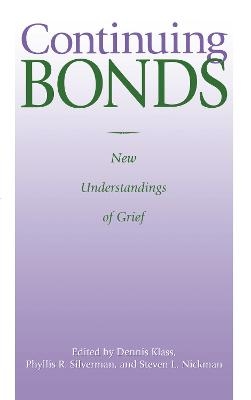
Continuing Bonds
Taylor & Francis Inc (Verlag)
978-1-56032-336-5 (ISBN)
First published in 1996. This new book gives voice to an emerging consensus among bereavement scholars that our understanding of the grief process needs to be expanded. The dominant 20th century model holds that the function of grief and mourning is to cut bonds with the deceased, thereby freeing the survivor to reinvest in new relationships in the present. Pathological grief has been defined in terms of holding on to the deceased. Close examination reveals that this model is based more on the cultural values of modernity than on any substantial data of what people actually do.
Presenting data from several populations, 22 authors - among the most respected in their fields - demonstrate that the health resolution of grief enables one to maintain a continuing bond with the deceased. Despite cultural disapproval and lack of validation by professionals, survivors find places for the dead in their on-going lives and even in their communities. Such bonds are not denial: the deceased can provide resources for enriched functioning in the present.
Chapters examine widows and widowers, bereaved children, parents and siblings, and a population previously excluded from bereavement research: adoptees and their birth parents. Bereavement in Japanese culture is also discussed, as are meanings and implications of this new model of grief. Opening new areas of research and scholarly dialogue, this work provides the basis for significant developments in clinical practice in the field.
Dennis Klass, Phyllis R. Silverman, Steven L., Nickman
Part 1 Examining the Dominant Model; Chapter 1 Introduction: What’s the Problem?, Phyllis R. Silverman, Dennis Klass; Part 2 Setting the Stage; Chapter 2 Broken Hearts or Broken Bonds?, Margaret Stroebe, Mary Gergen, Kenneth Gergen, Wolfgang Stroebe; Chapter 3 Grief That Does Not End, Paul C. Rosenblatt; Chapter 4 Grief in an Eastern Culture: Japanese Ancestor Worship, Dennis Klass; Part 3 Bereaved Children; Chapter 5 Children’s Construction of Their Dead Parents, Phyllis R. Silverman, Steven L. Nickman; Chapter 6 Bereaved Children’s Changing Relationships with the Deceased, Claude L. Normand, Phyllis R. Silverman, Steven L. Nickman; Chapter 7 Remembering a Parent Who Has Died: A Developmental Perspective, Betty C. Buchsbaum; Chapter 8 Relationship and Heritage: Manifestations of Ongoing Attachment Following Father Death, Kirsten Tyson-Rawson; Part 4 Spousal Bereavement; Chapter 9 Widowhood and Husband Sanctification, Helena Znaniecka Lopata; Chapter 10 Remarriage of Widowed Persons: A Triadic Relationship, Miriam S. Moss, Sidney Z. Moss; Chapter 11 Memories of the Death and Life of a Spouse: The Role of Images and Sense of Presence in Grief, Roberta Dew Conant; Part 5 Parental Bereavement; Chapter 12 The Deceased Child in the Psychic and Social Worlds of Bereaved Parents During the Resolution of Grief, Dennis Klass; Chapter 13 The Wounded Family: Bereaved Parents and the Impact of Adult Child Loss, Simon Shimshon Rubin; Part 6 Bereaved Siblings; Chapter 14 Basic Constructs of a Theory of Adolescent Sibling Bereavement, Nancy Hogan, Lydia DeSantis; Part 7 Adoptee Losses; Chapter 15 Retroactive Loss in Adopted Persons, Steven L. Nickman; Chapter 16 Grief and the Birth Origin Fantasies of Adopted Women, Susan Miller-Havens; Part 8 Meanings and Implications; Chapter 17 Grief and the Role of the Inner Representation of the Deceased, Samuel J. Marwit, Dennis Klass; Chapter 18 Attachment and the Reactions of Bereaved College Students: A Longitudinal Study, David E. Balk; Chapter 19 Dilemmas in Identification for the Post-Nazi Generation: “My Good Father Was a Bad Man?”, Lora Heims Tessman; Part 9 Conclusion; Chapter 20 Concluding Thoughts, Phyllis R. Silverman, Steven L. Nickman;
| Erscheint lt. Verlag | 22.2.1996 |
|---|---|
| Reihe/Serie | Death Education, Aging and Health Care |
| Verlagsort | Washington |
| Sprache | englisch |
| Maße | 152 x 229 mm |
| Gewicht | 635 g |
| Themenwelt | Sachbuch/Ratgeber ► Gesundheit / Leben / Psychologie ► Psychologie |
| Geisteswissenschaften ► Psychologie ► Trennung / Trauer | |
| Sozialwissenschaften ► Pädagogik ► Sozialpädagogik | |
| Sozialwissenschaften ► Soziologie ► Mikrosoziologie | |
| ISBN-10 | 1-56032-336-1 / 1560323361 |
| ISBN-13 | 978-1-56032-336-5 / 9781560323365 |
| Zustand | Neuware |
| Informationen gemäß Produktsicherheitsverordnung (GPSR) | |
| Haben Sie eine Frage zum Produkt? |
aus dem Bereich


